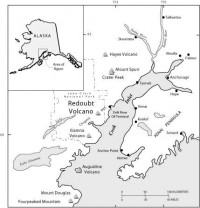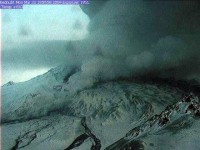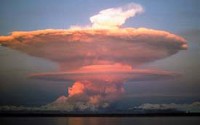UPDATE: Major eruption today (Thursday) at Mt. Redoubt with ash and gas cloud reaching AT LEAST 65,000 feet.
Alaska’s Mt. Redoubt volcano erupted several times starting late Sunday, sending ash plumes up to as high as an estimated 12 miles into the air, the Alaska Volcano Observatory reported. Geologists at the observatory say the volcano, located 100 miles southwest of Anchorage, began erupting at about 10:30 p.m. local time Sunday. “The ash cloud went to 50,000 feet, and it’s currently drifting toward the north, northeast,” said Janet Schaefer, a geologist with the Alaska Volcano Observatory. The wind patterns took the ash cloud away from Anchorage and instead headed toward Willow and Talkneetna, two communities near Mount McKinley, North America’s largest mountain in Denali National Park

The Anchorage Daily News reported that a fifth eruption took place sometime before 5 a.m. Alaska Daylight Time (AKDT), or 9 a.m. EDT Monday. “Another large explosion is occurring at Redoubt,” the AVO posted on its Web site 4:37 a.m. AKDT. “This is a fairly large eruption, close to the larger cities in Alaska,” said AVO geophysicist John Power. Another followed. As of Tuesday, at least 6 eruptions have taken place, with ash reaching as high as 12 miles (60,000 feet).

Read more here. See this radar loop from photo bucket and wunderground (H/T Tom Woods on WUWT).
Climatologists may disagree on how much the recent global warming is natural or manmade but there is general agreement that volcanism constitutes a wildcard in climate, producing significant global scale cooling for at least a few years following a major eruption. However, there are some interesting seasonal and regional variations of the effects.
We showed that Oman and Robock (2003) and others have shown that though major volcanic eruptions seem to have their greatest cooling effect in the summer months, the location of the volcano determines whether the winters are colder or warmer over large parts of North America and Eurasia. According to Oman, tropical region volcanoes like El Chichon and Pinatubo actually produce a warming in winter due to a tendency for a more positive North Atlantic Oscillation (NAO) and Arctic Oscillation (AO) - below left top and bottom. In the positive phase of these large scale pressure oscillations, low pressure and cold air is trapped in high latitudes and the resulting more westerly jet stream winds drives milder maritime air into the continents.
Oman found high latitude volcanoes like Katmai (Alaska in 1912) instead favored the negative phase of the Arctic and North Atlantic Oscillations and cold winters - right side top and bottom. In the negative phase, the jet stream winds buckled and forced cold air south from Canada into the eastern United States and west from Siberia into Europe. They also favored a cooling of middle and higher latitudes the year round of that atmosphere and a weakening of the summer monsoon in India. Is this event strong enough and the material injected into the stratosphere which is lower in high latitudes (well below 60,000 feet) large enough to have a major impact. That assessment will take a few days. Eruptions may continue for days or weeks or as in 1989/90, the time of the last Redoubt eruption, for months.

Mt. Redoubt when it erupted in 1989.




